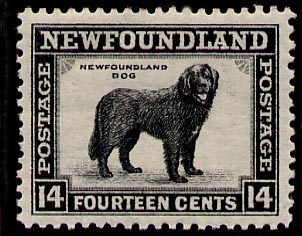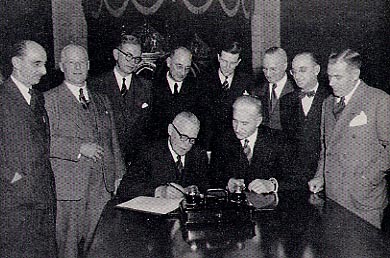
History

 |
Newfoundland History |
 |

Signing ceremony of the Terms
of Union in the Senate chamber, in Ottawa, on December 11, 1948.
Seated were Louis
St. Laurent, Prime Minister of Canada, and the Hon. A. J. Walsh,
head of the Newfoundland delegation. Joseph
R. (Joey) Smallwood is standing
(second from the right).
[This text was written in 1949. For the full citation, see the end of the text. The site editor has added parts in brackets [...], as well as images and links.]
Newfoundland's entry into the Canadian confederation; proposed and rejected three times since 1865, was finally accomplished and became effective on April 1, 1949.
The agreement, signed in Ottawa on December 11, 1948, contained fifty terms, to this general effect:
1-2. From the date of union, the island of Newfoundland, with adjacent islands and the coast of Labrador, as delimited in 1927 [indeed, by article 2, the government of Canada explicitly recognized the Judicial Committee of the Privy Council's decision of 1927 (alternative site where the JCPC decision is also given) concerning the boundary between Labrador and Canada/Quebec. The Canadian and Quebec governments had refused to recognize this decision between 1927 and 1949. The government of Quebec still refuses to recognize this decision today (2004) Several documents pertaining to this dispute are available at this address.] Labrador, became a part of Canada known as the Province of Newfoundland.
3. The British North America Acts, 1867 to 1946, applied to Newfoundland, with certain exceptions, as to the other provinces.
4-6. Newfoundland was entitled to be represented in the senate by six members, and in the Canadian House of Commons by members from the following electoral districts: Grand Falls-White Bay (including Labrador), Bonavista-Twillingate, Trinity-Conception, St. John's East, St. John's West, Burin-Burgeo, and Humber-St. George's.
7-16. The constitution of Newfoundland as it existed immediately prior to February 16, 1934, was revived and became, subject to the British North America Acts, the constitution of the province. Executive and legislative branches of the provincial government thus constituted were similar to those branches as they existed fifteen years previously, except that there was to be a lieutenant-governor instead of a governor, and the legislative council was not revived.
17. In lieu of section 93 of the B.N.A. Act, 1867, this term provided that the Newfoundland legislature had exclusive authority to make laws in relation to education, but no authority to make laws which would affect prejudicially the rights or privileges of denominational or amalgamated schools or colleges that had been provided by law, out of public funds, in Newfoundland at the date of union [This clause was amended following a referendum in Newfoundland in 1997. See the proclamation that came into force in 1998.]
18-22. All laws and regulations in force in Newfoundland at the date of union continued in force as if the union had never been made, but were subject to alteration or repeal by the appropriate authorities.

The Canadian beaver welcomes the Newfoundland dog into Canada.
(From a postal cover of 1949)
23-29. The federal government assumed responsibility for servicing and retiring the stock issued or to be issued on the security of Newfoundland pursuant to the Loan Act of 1933, and took over the sinking fund established under the Act. Provision was made for a tax agreement to be offered to Newfoundland similar to agreements offered other provinces. Canada agreed to pay Newfoundland an annual subsidy of $180,000, an annual subsidy of 80 cents per capita, and a special annual subsidy of $1,100,000 in recognition of the special problems of the province. A schedule of transitional grants was set up, diminishing from $6,500,000 in the first year to $350,000 in the twelfth year, and Canada agreed to appoint, within eight years of union, a royal commission to review the financial position of the province [The McNair commission reported in 1958 and recommended the continuation of transitional grants for Newfoundland. These were paid until 1962]. [Consult the 2002 Report of the Royal Commission on Renewing and Strengthening Our Place in Canada published by the Government of Newfoundland]
30-50. All lands, mines, minerals, and royalties belonging to Newfoundland at the time of union were retained by the province, but the federal government took over all property and responsibility connected with the following services: the Newfoundland railway, including steamship and other marine services; the Newfoundland hotel; postal and publicly-owned telecommunication services; civil aviation, including Gander airport; customs and excise; defence; protection and encouragement of fisheries and operation of bait services; geographic,topographical, geodetic, and hydrographic surveys; lighthouses, fog alarms, buoys, beacons, and other public works and services in aid of navigation and shipping; marine hospitals, quarantine, and the care of shipwrecked crews; the public radio broadcasting system; and other public services similar to those provided at the date of union for the people of Canada generally. Veterans' benefits, unemployment insurance, merchant seamen's benefits, family allowances, pension contributions, benefits under the National Housing Act, and all other welfare and public services were extended to Newfoundland on the same basis as to other provinces.

On the document appear the signatures of Louis St. Laurent
and Brooke Claxton
on behalf of Canada and Albert J. Walsh, F. G. Bradley, Philip
Gruchy, John B. McEvoy,
Joseph R. Smallwood and G. A. Winter on behalf of Newfoundland.
(See the biographical section of the site for information
on some of these Newfoundland individuals)
For the text of the agreement, see Canada, Terms of union of Newfoundland with Canada. (Ottawa, 1949). [The full text of the agreement is provided at this site.]
Source: W. Stewart WALLACE, ed., The Encyclopedia of Canada. Newfoundland Supplement, Toronto, University Associates of Canada, 1949, 104p., pp. 99-100.
© 2004 Claude Bélanger, Marianopolis College |